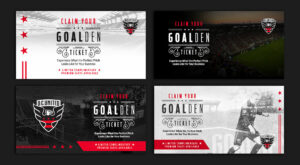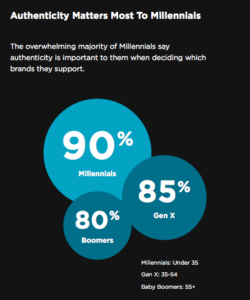You say you want a revolution, but do you really?
Branding is an integral part of any company’s identity. Not only does branding make a memorable impression on your consumers, but it sets the tone for what new and existing consumers can expect from you. Smart branding also offers a valuable opportunity to differentiate yourself from your competitors.
For companies who may get the sense, both internally and externally, that their brand is outdated, it could make sense to rebrand. Rebranding your entire company might seem like an intimidating proposition, however, rebranding doesn’t have to mean a major overhaul. Something as simple as updating your brand’s color palette or your content’s tone of voice can have a huge impact on how the brand is perceived, breathing new life into the already-established company identity.
That’s where Bluetext comes in. A full-service D.C. based marketing agency, Bluetext has refreshed the brands of some of the most premier companies in the country, balancing brand history with brand vision.
Bluetext suggests these five tips when considering your next brand refresh:
Determine Your ‘Why’
For many companies, it can be easy to express interest in a rebrand. However, a company must first realize why they want to rebrand. This ‘why’ will dictate the entire process and ensure the goals of the project are being realized. For example, your ‘why’ might be:
- Our messaging is confusing for consumers and isn’t aligned with how sales go to market.
- We need to differentiate ourselves and stand out from our competitors in the market.
- We’re going after a new audience and need a brand that speaks to that market.
- Our company has expanded and we need a brand that is modern, flexible, and future-proof.
- Our brand and accompanying brand story is outdated and no longer reflects the company’s values.
- We recently went through a merger or acquisition and we need to hone in under one cohesive brand identity.
- Our brand doesn’t create a memorable impression on our target audience.
Invest in High-Quality Content and Visuals
It may seem simple, but investing in high-quality content portrays a degree of professionalism to your clients. Stock imagery might be tempting, but the personality of high-quality content and visuals will help you stand out in the market, increasing your relatability with your clients. See how Invictus reaped the rewards of investing in high-quality content.
Invictus Brand Manifesto from Bluetext on Vimeo.
Change Your Brand Colors
Depending on the size of your company and the amount of signage and collateral you own, changing your brand colors can be either a minor task or a large undertaking. Business psychology reminds us that colors have different effects on different consumers. Red, for example, can elicit feelings of warmth, excitement, and intensity. Green, on the other hand, can elicit feelings of tranquility, health, and harmony.
Deciding what emotional experience you want your customers to associate with your brand can send a very clear and competitive message to the market. For example, McDonald’s conducted a brand overhaul in 2009 across Europe, trading out their signature red logo, for more of an earthy-green look. This tactic was implemented to promote a more eco-friendly image, alongside other earth-friendly transitions such as environmentally friendly refrigeration and converting used oil into biodiesel fuel. The idea caught on so well, McDonald’s has gradually updated its restaurants nationwide with the refreshed color palette.

Focus on a New Facet of Your Story
If you have a sound brand offering in the market, you may just need to find a new story to tell. Keeping your messaging fresh and personal can excite your consumers, attract potential leads, and elevate your reputation in a busy industry. See how Bluetext partnered with D.C. United to create a multi-touch, multi-channel campaign to deliver messaging across multiple digital channels, social media, email, and microsites.

Act More Human
Authenticity is everything in marketing, there’s no question about it. In a recent survey by Stackla, 86% of consumers say authenticity is important when deciding which brands to like and support, with the most emphasis placed on authenticity by Millenials. Consumers want to connect with the companies they interact with. Promotional sales messaging can come off as disingenuous and pushy. Putting in the effort to bring an authentic and unified brand, campaign, or product message to market will make a bigger impact and ROI every time. Whether its social, blogs, email blasts, premium content, or even in-person communications, an authentic narrative will establish an authentic connection between your consumers and their advocacy for your company.

There are a plethora of ways to tweak your brand and excite your market potential. A top branding agency will tell you how a little can go a long way. Focusing on some low-hanging fruit can delay a full-scale revolution and save you time and money.
For more information for a refreshing brand opportunity with Bluetext, explore our case studies, work, and processes at www.bluetext.com/branding
Leading brands often turn to Bluetext to achieve their branding and marketing goals, helping them to increase sales, reach new target audiences, and grow beyond their expectations. In many cases, the goal is a successful acquisition, rewarding investors and other stakeholders for their support while putting them in the position for continued growth. That’s why challenger brands often partner with a leading marketing agency, like Bluetext, to put them in the position for a rewarding acquisition or merger.
The latest M&A success story involves KnightPoint and Perspecta, two companies Bluetext helped when they both needed a new brand and a new website. When Vencore and KeyPoint merged to form Perspecta, a government services provider with 14,000 employees and pro-forma revenues of $4.2 billion, they turned to Bluetext to develop and launch the company’s website under its new vibrant brand. With a new look, feel, and website, Perspecta was ready to take on something big. In early August, it was announced that Perspecta would acquire KnightPoint, another former Bluetext client who provided comprehensive managed services and solutions and specialized in modernizing IT, for $250 million. Needless to say, we are incredibly proud of both Perspecta and KnightPoint.


We have also had the pleasure of working with other brands who have seen recent success in the M&A arena and thought that this would be a good time to recognize many of those success stories. More importantly, it demonstrates the range of services that can help drive a growth strategy that leads to a rewarding acquisition. Here’s just a sampling of clients who have reached their M&A goals:
- Cigital: As an extremely successful security consulting company, Cigital built a strong business helping companies drive best practices in building security into their applications and software. As the company was looking to expand both globally and to a broader audience of companies who need to understand the importance of application security testing earlier in their development life-cycle, Cigital turned to Bluetext to completely rebrand the company. As a result, publicly-traded Synopsys agreed to acquired Cigital in 2016.

- Acentia: When the new CEO of IT Solutions – a roll-up of nine IT government contracting firms – was brought on board by its private equity owners, he turned to Bluetext to position this new company for growth, visibility, and a successful sale. Following a thorough discovery process, Bluetext proposed the name Acentia and launched the new brand identity, with a powerful website to better represent its mission supporting customers on programs of National Significance. Bluetext worked closely with the entire Acentia management team, employees and customers to overhaul its messaging, establish a new name, create its brand, design and develop a new responsive website, and re-launch the company to the public. In the end, Acentia was acquired by Reston-based Maximus Inc. for $300 million.

- Force3: Force3 is one of the fastest-growing network security services and solutions company servicing the Federal Government with revenues of more than one billion dollars annually. When its brand, messaging and website needed an update, it turned to Bluetext. Shortly after help from Bluetext, Force3 was acquired by Sirius Computer Solutions as a way to better service customers in the Mid-Atlantic region.

- Altimeter: The Altimeter Group, based in Silicon Valley, is one of the hottest research, analyst and consulting firms in the digital market. It turned to Bluetext for a makeover of its brand. Bluetext designed a new approach to the market, including how it presents its name, its image and all of its digital and physical assets. Consequentially, Altimeter was acquired by consulting powerhouse Prophet.

- Sourcefire: A $2.7 billion Cisco acquisition is the culmination of a Sourcefire’s journey from startup to a global leader. Bluetext was there the entire way, with a partnership over 8 years and 2 global rebrands.

- BroadSoft: BroadSoft was a leading global provider of software that enables service providers to deliver unified communications services to their customers. In early 2014, realizing that they needed to up their visual identity and brand, BroadSoft turned to Bluetext. The effort resulted in a global brand designed that enabled the company to target new customers and new markets and drive new solutions into the market. In the end, Broadsoft’s new brand and CVI helped them get acquired by Cisco.

October 26, 1994 is a day that will be forgotten by few…it was the first day a banner ad (or any ad for that matter) was posted on the internet. AT&T paid $30,000 for the appearance of the first banner ad. While we have seen an explosion in the variety of ad types on the internet since then, banner ads still remain among the most popular. Banner ads are rectangular displays that appear on web pages but can vary in appearance, theme, and content. Even though banner ads may seem like a rudimentary advertising technique, they are still an incredibly useful tactic used by brands across the world. Here are four reasons why Bluetext believes banner ads are still an asset to any company.
-
Banner Ads Can Have Different Presentation Elements
Nowadays, banner ads are just downright pretty. Thanks to the evolution of graphic design, banner ads can include elements such as graphics, video, audio, and everything in between. As the world of paid media continues to grow, banner ads have evolved alongside. In recent years, it has become evident that animated banner ads are far more effective – and engaging – than static ads. In fact, animated banner ads can help increase conversion by up to 73%. The catch, however, is that animated banner ads are not easy to produce without a team of animators, especially with normal file sizing in mind. Luckily, a branding agency such as Bluetext has an experienced creative team, which proved helpful when the Graduate Management Admission Council (GMAC) needed help with a brand redesign. Part of this redesign included a new media campaign that presented personalized content through captivating visuals, engaging messaging, and efficient audience septation; in short, it helped ensure that the right message was going to the right person at the right time. As a result, GMAC saw a 153% increase in website content clicks and 400,000 more microsite visitors.

-
Banner Ads Increase Awareness of Your Brand and Products
While banner ads may be helpful in driving immediate sales, they also play a larger role in building brand recognition, which is vital when internet users don’t immediately click on an ad. Studies have shown that banner ads are a great way to keep your brand top-of-mind when it comes time for a customer to buy your product, which is helpful considering 73% of internet users in the United States over the age of 14 buy products online. Additionally, even though web users may not be directly looking or focusing on your ads, they will be subconsciously exposed to your brand and products through banner ads. While the ultimate goal is to drive sales, banner ads are a fantastic way to keep your company, your brand, and your products on the minds of consumers.

-
Banner Ads are Easily Measurable
One of the most beneficial aspects of modern-day advertising is our ability to measure the successes of the campaigns a company like Bluetext can help you run. Thanks to programs such as Google Ads and Google Analytics, we can measure data points that tell us how many people saw your ad, how many people clicked on your ad, how many people made a purchase after viewing your ad, and so much more. With help from these tools, we know the average click-through-rate for a banner ad is 0.07%. While this number may seem low, it is necessary to recognize that it has a higher action rate than billboard (.03%) and television (.05%) ads.

-
Banner Ads Support Retargeting
Have you ever put an item in your shopping cart and let it sit, only to see ads for that same product pop up all over your web pages? This tactic is referred to as ‘retargeting,’ which helps drive users to complete their orders (or other low-funnel action). Studies have shown that users who are exposed to retargeting banner ads are 70% more likely to complete the desired action. If that isn’t convincing enough, remember how we said the average click-through-rate for a banner ad is 0.07%? Well, the average click-through-rate for a retargeting banner ad is 0.7%, 10 times the amount!
Clearly, banner ads, especially animated ads, have their pros. With some of those pros in mind, it is vital to remember a few key tips when running a banner ad campaign. First, update your ads! Click-through-rate decreases by nearly 50% after running the same group of ads for five months. Secondly, as only 8% of customers return to their cart to finish a transaction without retargeting, it is vital to allocate some of your advertising budget to retargeting campaigns. Lastly, don’t get discouraged if your banner ads have a low click-through-rate. Other metrics, such as impressions, can show us how many people have seen the ad, even if they haven’t clicked on it. In short, banner ads are a key advertising method to drive sales and boost brand awareness. While banner ads are great alone, they are most effective when paired with other types of advertising techniques, such as paid search.

